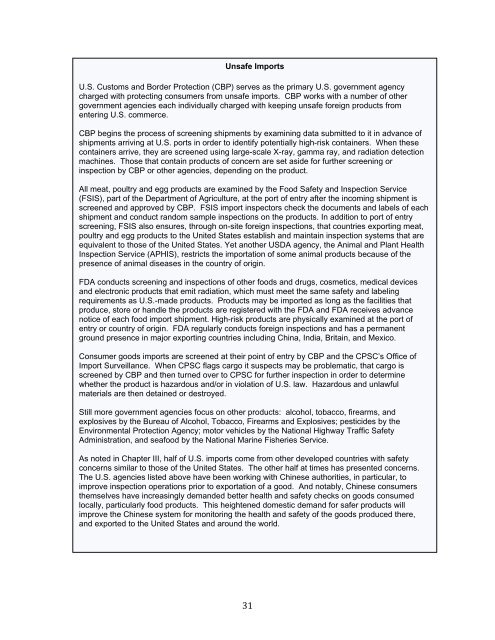You also want an ePaper? Increase the reach of your titles
YUMPU automatically turns print PDFs into web optimized ePapers that Google loves.
Unsafe <strong>Imports</strong><br />
U.S. Customs and Border Protection (CBP) serves as the primary U.S. government agency<br />
charged with protecting consumers from unsafe imports. CBP works with a number of other<br />
government agencies each individually charged with keeping unsafe foreign products from<br />
entering U.S. commerce.<br />
CBP begins the process of screening shipments by examining data submitted to it in advance of<br />
shipments arriving at U.S. ports in order to identify potentially high-risk containers. When these<br />
containers arrive, they are screened using large-scale X-ray, gamma ray, and radiation detection<br />
machines. Those that contain products of concern are set aside for further screening or<br />
inspection by CBP or other agencies, depending on the product.<br />
All meat, poultry and egg products are examined by the Food Safety and Inspection Service<br />
(FSIS), part of the Department of Agriculture, at the port of entry after the incoming shipment is<br />
screened and approved by CBP. FSIS import inspectors check the documents and labels of each<br />
shipment and conduct random sample inspections on the products. In addition to port of entry<br />
screening, FSIS also ensures, through on-site foreign inspections, that countries exporting meat,<br />
poultry and egg products to the United States establish and maintain inspection systems that are<br />
equivalent to those of the United States. Yet another USDA agency, the Animal and Plant Health<br />
Inspection Service (APHIS), restricts the importation of some animal products because of the<br />
presence of animal diseases in the country of origin.<br />
FDA conducts screening and inspections of other foods and drugs, cosmetics, medical devices<br />
and electronic products that emit radiation, which must meet the same safety and labeling<br />
requirements as U.S.-made products. Products may be imported as long as the facilities that<br />
produce, store or handle the products are registered with the FDA and FDA receives advance<br />
notice of each food import shipment. High-risk products are physically examined at the port of<br />
entry or country of origin. FDA regularly conducts foreign inspections and has a permanent<br />
ground presence in major exporting countries including China, India, Britain, and Mexico.<br />
Consumer goods imports are screened at their point of entry by CBP and the CPSC’s Office of<br />
Import Surveillance. When CPSC flags cargo it suspects may be problematic, that cargo is<br />
screened by CBP and then turned over to CPSC for further inspection in order to determine<br />
whether the product is hazardous and/or in violation of U.S. law. Hazardous and unlawful<br />
materials are then detained or destroyed.<br />
Still more government agencies focus on other products: alcohol, tobacco, firearms, and<br />
explosives by the Bureau of Alcohol, Tobacco, Firearms and Explosives; pesticides by the<br />
Environmental Protection Agency; motor vehicles by the National Highway Traffic Safety<br />
Administration, and seafood by the National Marine Fisheries Service.<br />
As noted in Chapter III, half of U.S. imports come from other developed countries with safety<br />
concerns similar to those of the United States. The other half at times has presented concerns.<br />
The U.S. agencies listed above have been working with Chinese authorities, in particular, to<br />
improve inspection operations prior to exportation of a good. And notably, Chinese consumers<br />
themselves have increasingly demanded better health and safety checks on goods consumed<br />
locally, particularly food products. This heightened domestic demand for safer products will<br />
improve the Chinese system for monitoring the health and safety of the goods produced there,<br />
and exported to the United States and around the world.


